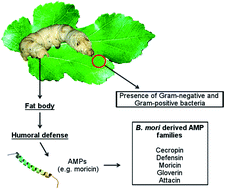Antimicrobial peptides from Bombyx mori: a splendid immune defense response in silkworms†
Abstract
Bombyx mori L., a primary producer of silk, is the main tool in the sericulture industry and provides the means of livelihood to a large number of people. Silk cocoon crop losses due to bacterial infection pose a major threat to the sericulture industry. Bombyx mori L., a silkworm of the mulberry type, has a sophisticated inherent innate immune mechanism to combat such invasive pathogens. Among all the components in this defense system, antimicrobial peptides (AMPs) are notable due to their specificity towards the invading pathogens without harming the normal host cells. Bombyx mori L. so far has had AMPs identified that belong to six different families, namely cecropin, defensin, moricin, gloverin, attacin and lebocin, which are produced by the Toll and immune deficiency (IMD) pathways. Their diverse modes of action depend on microbial pathogens and are still under investigation. This review examines the recent progress in understanding the immune defense mechanism of Bombyx mori based on AMPs.

- This article is part of the themed collection: 2020 Reviews in RSC Advances


 Please wait while we load your content...
Please wait while we load your content...